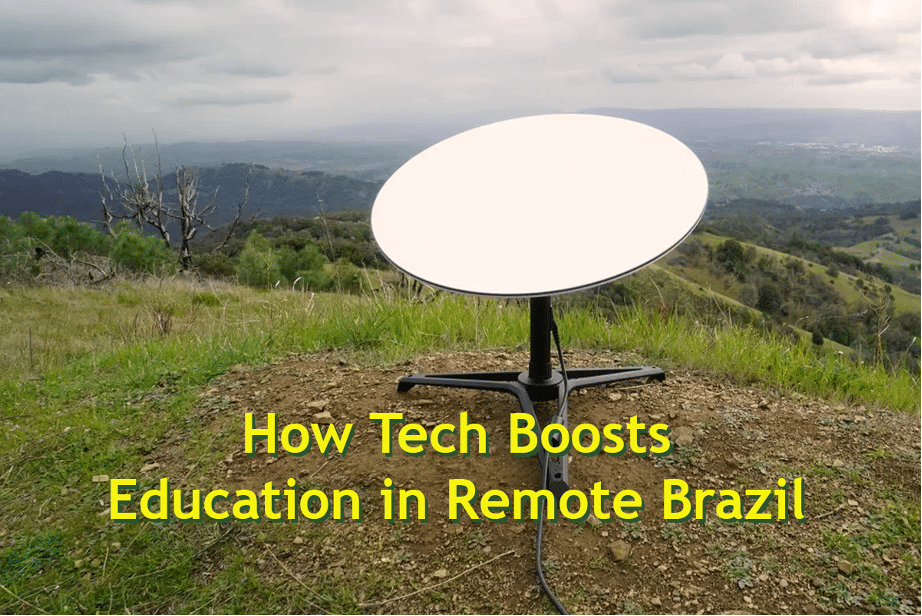For remote areas of Brazil where geographical isolation and economic imbalance impede educational progress, access to high-quality education remains a major difficulty. Still, technological developments are helping to close this distance rather significantly. Technology is changing how rural community students interact with learning possibilities by providing creative tools and resources.
A Brazilian education expert, Cláudia Costin, notes, “A tecnologia está transformando o acesso à educação ao reduzir desigualdade social e promover direitos humanos, focando na segurança pública, um dos grandes temas de redação de políticas públicas.” – “Technology is transforming access to education by reducing social inequality and promoting human rights, focusing on public security, which is one of the major essay topics in public policy.”
Overcoming Geographical Barriers
Long distances and poor infrastructure have for decades hindered access to schools for children and young adults living in remote areas of Brazil.
By means of online connections between students and teachers and instructional materials, e-learning systems are transforming this situation:
- Digital Classrooms: Platforms such as Google Classroom and Moodle have become accessible to students in isolated areas.
- Mobile Learning: Smartphones and tablets are increasingly used to deliver lessons and study materials.
Recent research indicates that more than 70% of Brazilian students already own mobile devices, allowing even those living far away to engage in online courses. Almost anything is now available online, from recipes for cooking to thorough math problem solutions, therefore improving the access to knowledge and resources.
Policies Supporting Digital Education
Public policies and governmental initiatives play a pivotal role in driving technological integration into Brazil’s education system, particularly in remote and underserved areas. These policies aim to ensure that all students, regardless of geographic or economic circumstances, can access quality learning opportunities.
Educação Conectada: Bridging the Digital Divide
One of the most impactful programs is Educação Conectada, a government initiative focused on improving internet connectivity in public schools, particularly in rural regions. This program provides schools with the necessary infrastructure, such as high-speed broadband and digital devices, enabling them to participate in the digital transformation of education.
Infrastructure Development
Significant investments are being made in expanding infrastructure to support digital education. These include:
- Fiber Optic Networks: Extending broadband connections to rural schools and communities.
- Hardware Distribution: Providing computers, tablets, and other digital devices to students and educators.
- Maintenance Support: Ensuring that the equipment provided remains functional over time.
These efforts aim to close the technology gap between urban and rural areas, creating a more equitable educational environment.
Teacher Training Programs
Recognizing that technology is only as effective as the people using it, public policies also emphasize teacher training. Programs are designed to help educators integrate technology into their teaching methods effectively, ensuring that digital tools enhance, rather than complicate, the learning process. Training initiatives include:
- Workshops and Online Courses: Focused on digital literacy and the use of e-learning platforms.
- Peer Support Networks: Encouraging knowledge sharing among teachers to spread best practices in digital education.
- Ongoing Professional Development: Keeping educators updated on the latest technological advancements and teaching strategies.
Incentives for Technological Adoption
To encourage schools to embrace technology, the government provides various incentives, such as:
- Grants for Schools: Funding to purchase technology and improve infrastructure.
- Subsidized Internet Plans: Making it affordable for schools to maintain consistent internet access.
- Partnerships with Private Sector: Collaborations with tech companies to provide tools, training, and resources at reduced costs.
Addressing Equity and Inclusion
A critical aspect of these policies is addressing equity and inclusion, ensuring that the most vulnerable populations benefit from technological advancements. For example:
- Programs for Indigenous and Remote Communities: Initiatives tailored to bring culturally relevant educational content to these regions.
- Support for Students with Disabilities: Ensuring digital tools are accessible for those with special needs.
Monitoring and Evaluation
To ensure the success of these policies, continuous monitoring and evaluation are conducted. Data is collected to measure:
- The increase in internet access and device availability.
- Teacher proficiency in using digital tools.
- Student outcomes and engagement with technology.
By using this data, the government can refine its strategies and focus resources where they are needed most.
Impact of Policies on Education
The results of these policies have been promising. Schools that previously struggled with limited resources now have access to digital libraries, online classes, and virtual labs. Students in remote areas are engaging in learning activities that were once available only to their urban counterparts. Moreover, the emphasis on teacher training ensures that these tools are being used to their full potential, creating a ripple effect that improves overall educational outcomes.
Future Directions
Public policies must adapt to address emerging challenges. Key areas for future focus include:
- Expanding 5G networks to enhance connectivity.
- Promoting the use of artificial intelligence to personalize learning experiences.
- Encouraging the development of local digital content that aligns with Brazil’s cultural and educational needs.
By sustaining and expanding these efforts, Brazil can continue to use technology as a powerful tool to transform education and reduce inequalities across the country.

Promoting Social Equality
Technology in education not only connects but also empowers. Interactive platforms foster inclusivity, ensuring students with disabilities or language barriers can engage with the material. For instance:
- Accessible Learning Materials: Resources for visually or hearing-impaired students: subtitles, audio descriptions, flexible formats.
- AI-Powered Tools: Translation and language recognition tools driven by artificial intelligence enable indigenous people to access knowledge in their own languages.
These advancements play a vital role in addressing desigualdade social (social inequality) by giving marginalized communities the tools to participate in the broader economy and society.
Inspiring Case Studies
Several initiatives have demonstrated the transformative power of technology in Brazil’s educational landscape:
- Projeto Aluno Conectado: Providing internet access and digital resources to low-income students.
- Telecurso: A government-backed initiative delivering televised lessons to remote areas, which has now expanded to include online components.
- NGO Efforts: Organizations like Fundação Lemann and Todos Pela Educação actively pursue including technology into educational institutions.
Challenges and Opportunities
Notwithstanding great advancement, problems still exist. Many remote areas lack reliable internet access and face shortages of devices. However, the increasing affordability of technology offers hope. Programs to recycle and redistribute older devices, combined with satellite-based internet services, are potential solutions to these barriers.
How Technology Supports Lifelong Learning
Another critical impact of technology is its role in lifelong learning. For instance, adults in remote areas now have access to online courses, vocational training, and even college-level education. Platforms like Coursera and Khan Academy have seen significant uptake in rural Brazil, offering opportunities for personal and professional growth.
The Future of Education in Brazil
The advantages will compound as Brazil keeps implementing digital education strategies. Using virtual reality, artificial intelligence, and data analytics can let teachers design customized learning environments fit for particular student requirements. Encouragement of cooperation between public and commercial sectors can also help to hasten the application of creative ideas.
Technology is becoming a need rather than a luxury if it is to guarantee educational equality in far-off Brazilian regions. Public policies, e-learning tools, and creative initiatives help students in the most remote areas of the nation access heretofore unthinkable resources. The future promises to be more inclusive and educated as Brazil keeps spending in these solutions.
By giving technology developments first priority, we can build an educational ecosystem that meets the particular needs of every student and helps them to realize their full potential, therefore contributing to a better future.
